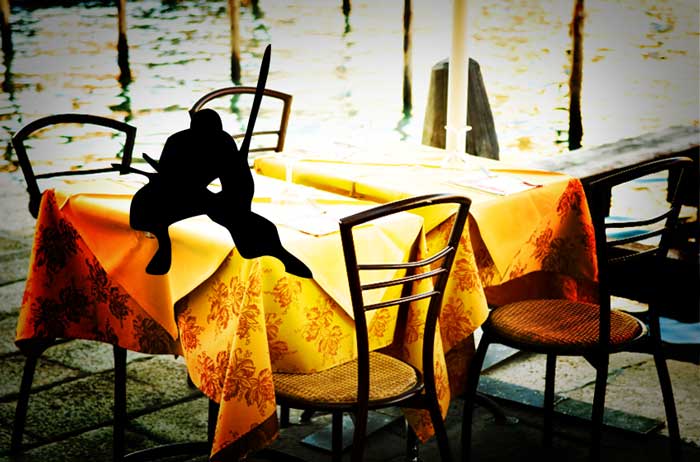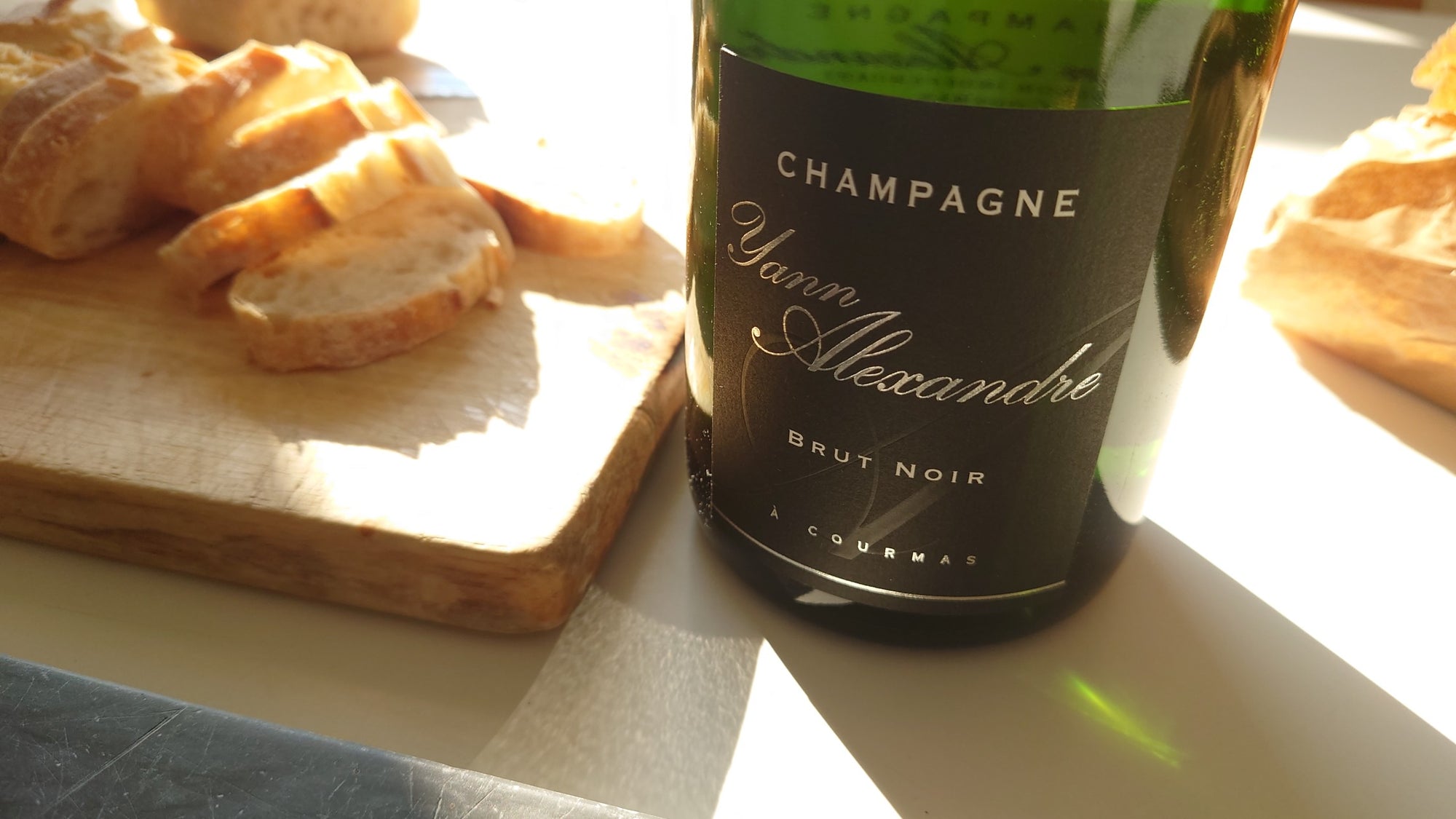I’ve been to my share of bad restaurants. I still somehow do. Anyone who’s ever spent any time at a bad restaurant knows that there are costs beyond the obvious waste of time and money. They can easily ruin a lovely day or vacation by triggering foul moods, arguments, queasy tummies or worse.
So instead of just complaining, I’ve put together a fail-safe method of how to spot a bad restaurant instantaneously. In theory it should work in the same way that a ninja assesses a threat: in a split second tallying the number of enemies, judging their skill level, determining exit routes, etc. You’ll usually have more time than a split second as the restaurant won’t be attacking you . . . unless you let it.
If more than one of these tell-tale signs crop up, you can be pretty sure that the eatery in question is indeed a BAD RESTAURANT: 1. Photographs of food 2. Pastel tablecloths 3. Glass plates 4. Long menus 5. Always empty 6. No food in sight 7. Dry 8. Loud music 9. Filthy 10. Bad toilets 11. Bad smells 12. Bad plating 13. Themes
Photos of Food Photos could come in handy to avoid embarrassing misunderstandings. The local delicacy of Tordesillas, Spain is a grey pile of boiled chicken skin and bones, a fact that could easily be cleared up with a picture. Still it’s usually better to give places with photos a pass. I’ll begrudgingly grant a waiver to Asian restaurants on this one, but otherwise it’s a giveaway that the restaurant’s main market segment is either tourists or grunting illiterate troglodytes. For some good examples, take look at Harmon Leon’s Bad Restaurant Food Photography.
Pastel Tablecloths Pastel colored tablecloths are about as fashionable as the Queen’s handbag and a surefire indication that the menu hasn’t changed since 1973; an ancient form of trickery used to distract from drab cuisine. Especially treacherous when deployed in diagonal layers.
Glass Plates  Glass plates sound like a good idea in theory: food floating on a transparent surface. Wait, scratch that. That actually sound like a really bad idea. In order to sell more product, the drinking glass industry has somehow convinced more than a few unwitting restaurateurs that glass plates are a refreshing and stylish twist in tableware. Yes! And they really come into their own when that pastel tablecloth shows through, visually intermingling with your hamburger patty, cottage cheese and pineapple ring (or equivalent) main course. Don’t let it happen to you.
Glass plates sound like a good idea in theory: food floating on a transparent surface. Wait, scratch that. That actually sound like a really bad idea. In order to sell more product, the drinking glass industry has somehow convinced more than a few unwitting restaurateurs that glass plates are a refreshing and stylish twist in tableware. Yes! And they really come into their own when that pastel tablecloth shows through, visually intermingling with your hamburger patty, cottage cheese and pineapple ring (or equivalent) main course. Don’t let it happen to you.
Long Menus When the menu makes an audible “thud” as it hits the table, beware. While it’s great for the wine list to have some heft, the same thing in a menu should send alarm bells off. Vintage food anyone?
Always Empty What if you threw a party and nobody came? Sadly this happens to many restaurants. Or they may just be a front for money laundering. The key term here is “always”. Some excellent restaurants are sometimes empty so this isn’t going to be an instant indicator. So much for our ninja approach.
No Food in Sight Every once in a while I walk into a restaurant where there’s nothing to betray the fact that food is actually being served. It’s especially unnerving when the place is crowded, giving the effect of a giant waiting room with tables. More shocking is that some people actually decide to join the people sitting at tables in sitting at tables. Hit the doors running.
Dry No wine, no alcohol, no BYOB – no fun. I can live without wine and even without drinking any form of alcohol during a meal, but the puritanical approach to restauranteering is a reliable indicator that your meal will be every bit as enjoyable as a trip to the proctologist.
Loud Music I don’t mind loud music but would rather have a conversation than headbang through dinner. Mario Batali’s often parodied soundtrack at Babbo, was (is still?) heavy on the Ozzy but at least the music wasn’t played at deafening levels. I remember a new local fish restaurant that looked promising but blasted Fogat (the musical equivalent of a mullet – the hairstyle, not the fish). When asked if it could be turned down a little, our waiter said that it was part of the “concept.” The crescendo of the concept must have been with the restaurant closing 2 months later in screaming guitars; Eddie Van Halen’s Eruption towering as the doors slam shut for the last time.
Filthy One man’s filthy is another man’s Denmark. Accept only what you feel entirely comfortable with. If your dirty fork is replaced by an equally dirty fork, apologize to the waiter for having to leave because of an appointment (with basic hygiene) that you somehow forgot.
Bad Toilets I once ate at a place where the men’s toilet had been replaced by an orange traffic cone. Everyone felt sick afterwards. Go figure.
I once ate at a place where the men’s toilet had been replaced by an orange traffic cone. Everyone felt sick afterwards. Go figure.
Bad Smells If the food smells bad, then head for the door if you’re not already outside. This is obvious, but other ambient bad smells may not be so easily assessed. The main and pretty much only criterion is if they will soon pass. In the Florida Keys there was a waterside al fresco hotel restaurant that looked appealing. But what was that sickly perfumed smell? Little machines were wafting out a masking perfume over something now obviously and hideously sulfurous. The waiter didn’t know “what we were talking about”. Before we could be hacked up and thrown into the lagoon to refresh the odious stench of death, we ran for the car.
Bad Plating Sorry, but if the food looks bad, it probably is. One of the most disturbing examples of bad plating I’ve ever encountered was at the famous M. Manze pie shop in Southeast London. The potatoes are first run through a mechanical masher which makes them look like congealed spaghetti. To add insult to injury, the mash is then scraped onto the side of the plate giving the impression that said plate was used to shovel a small hillock of slop off the floor. Fail.
Themes I don’t need to tell you this, but themed restaurants are universally horrible. Sometimes it’s not obvious, especially when traveling with children. Are Chinese restaurants themed restaurants? No, a Chinese restaurant is a Chinese restaurant, unless its t shirt shop is larger than its kitchen.
This is a work in progress. The list could go on and on. Please let me know if you have any other surefire tips to assess the threat of a potentially bad restaurant. Together we can save humanity from a world of culinary woe.




Comments
Ryan – thanks for the excellent local knowledge!
The big plastic figures are definitely “do not enter” signs – just think of the completely warped frame of mind necessary to get one. “I’ve got it! Lets go to the carnival supply shop and buy a giant fiberglass lobster/fish/chef/viking/waiter.” And the psychotic delirium (or just cluelessness) required to set it out each day. I’ll have to add it to the list.
Here in Spain the photos do help from time to time…and in some places indicate quality. Though rarely. That said, in Madrid the dirtier the floor in the bar, the more you should go in. If you have ankle high debris it’s a sure sign that the tapas are AMAZING! When we first moved there we had a friend tell us that they wouldn’t go in for tapas if the floor was clean.
One that you forgot are the large sculptures outside holding menu’s which sit outside the restaurant. Usually a plastic lobster with a menu in hand is a sure sign to stay away. That said, once in Madrid a very well to do friend took me to a Galician place with a large clam or similar seafood critter with fake smile guarding the front entrance. I laughed, but it turned out that the food was amazing…and the fake fish outside had been a gift the owner did not want to get rid of. Always exceptions I guess!